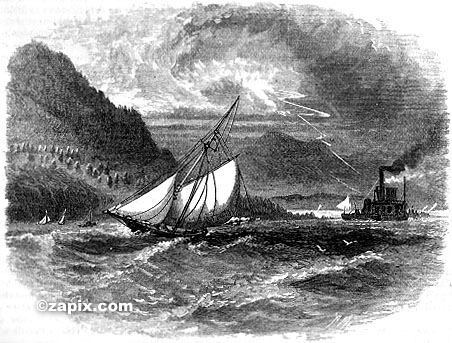|
|
The Romance of the Hudson, Part I, continued
 The Donder Berg.
a British squadron, bearing a British army under Sir Henry Clinton, working mightily to enslave the Americans. On the upper verge of that bay, on the western shore, is seen a high, rocky, solitary promontory crowned by a light-house. On the opposite side is seen a promontory more gentle in aspect, and containing a considerable village. The former is Stony Point, the latter is Verplank's Point. Upon these the baronet landed his troops. With a part of them he swept around the lofty Donder Berg above, from Stony Point, and falling with heavy force upon Forts Clinton and Montgomery in the Highlands, feebly manned by the Americans, captured them. He was seeking to form a junction with Burgoyne, then struggling with armed American yeomen on the borders of the Upper Hudson. But Clinton was foiled. He constructed a fort on Stony Point and garrisoned it but did not carry victory above Anthony's Nose. The embankments of that fort may be seen in front of the light-house.
Almost two years later Stony Point was the scene of another stirring romance. The chances for success in a night assault upon the garrison there were talked over at the head-quarters of Washington at West Point. The impetuous General Wayne — "Mad Anthony" — was then in command of troops in that vicinity. "Can you take the fort by assault?" Washington asked Wayne. "I'll storm hell, general, if you'll plan it!" was the reply. "Try Stony Point first," solemnly answered the chief. An assault was planned, and on a hot July night, when all the dogs in the neighborhood had been killed to prevent their barking making a discovery, Wayne, with a small force, crawled unobserved, under cover of darkness, to the narrow causeway across a marsh that connects the promontory with the land. They had ascended the rocky acclivity and were almost to the sally-port before a sentinel discovered them. Then the garrison was aroused, the drums beat to arums, and in the face of a terrible storm of grape-shot the assailants pressed forward with the bayonet. At two o'clock in the morning of July 16, 1779, Wayne, who had been stunned by a bullet, wrote to his chief, "The fort and garrison, with Colonel Johnson, are ours." The cannon were carried away on bateaux to West Point an the fort was destroyed. After passing the two points, the voyager finds broad and beautiful Peekskill Bay spread out before him, appearing like the northern termination of the arm of the sea, as the yet salt Hudson seems to be. But soon the magnificent serpentine sweep of the stream around the Donder Berg and Anthony's Nose dispels the illusion, and the Highlands rise in their grandeur on each side, flanking the river with wooded hills more than a thousand feet in height along a distance of more than ten miles. To the |
|
Page 14
Books & articles appearing here are modified adaptations
from a private collection of vintage books & magazines. Reproduction of these pages is prohibited without written permission. © Laurel O'Donnell, 1996-2006.
|
|

